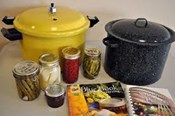A challenging economy and growing interest in eating local is turning the art of preserving food at home into a popular food trend. Preserving food was a simple fact of life for many of our grandparents’ generation, but today’s home canners are often budget-savvy consumers who know the value of eating healthy, garden-fresh foods throughout the year.
No matter what your reason for canning, food safety is an essential part of the process, says Barbara Ingham, Cooperative Extension food safety specialist.
Ingham offers tips and resources to help you be sure the food you preserve is safe to eat, whether it comes from your garden, a local farmers’ market or the grocery store.
First, start with a research-tested recipe, says Ingham. “Just because a recipe is in print doesn’t mean it’s safe for you and your family.” She recommends using recipes from the National Center for Home Food Preservation website at http://www.uga.edu/nchfp/.
Next, use recipes that are up-to-date. “If you’re using a recipe earlier than 1994, it’s a good idea to set it aside and find a current one that’s been tested for safety,” Ingham says.
Be sure your equipment is in good working order. A boiling water canner should have a flat bottom so that it fits nicely on the stovetop, and a tight-fitting lid. “If you have a dial gauge canner, it should be tested every year for accuracy,” Ingham advises. Steam canners are not recommended as a replacement for boiling water canners.
“A final note on canners,” says Ingham. “Don’t use a pressure cooker, sometimes called a pressure saucepan, as a pressure canner unless the pressure cooker is big enough to easily hold four quart jars.”
Use only standard home canning jars—not old mayonnaise jars. It’s fine to reuse canning jars as long as they are not chipped or cracked. “Garage sales can be great places to locate used canning jars,” says Ingham. “Just make sure they are designed for canning.” Canning lids should have both a lid and reusable band. Use each lid only once.
Finally, always follow the recipe directions carefully. “Leave your creativity behind,” Ingham advises. “Home canning is one area where being creative can lead to food safety disasters.”







